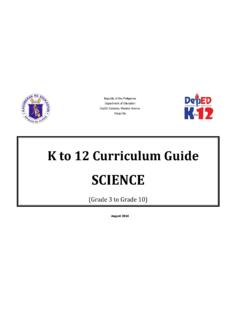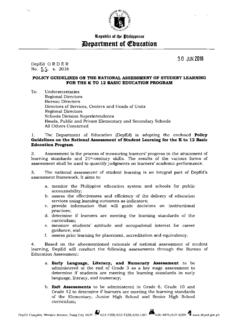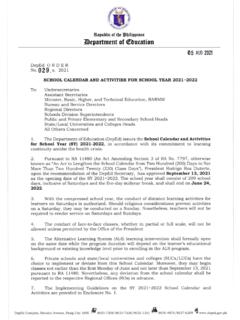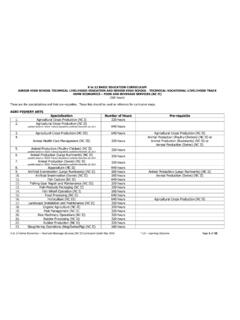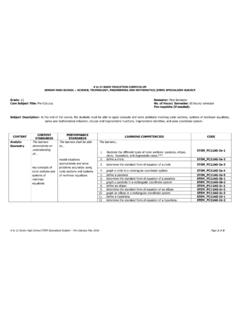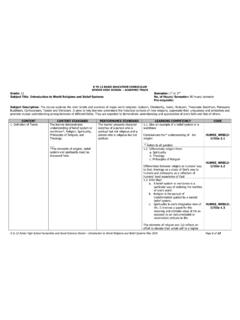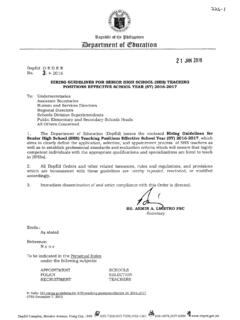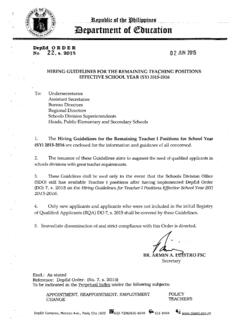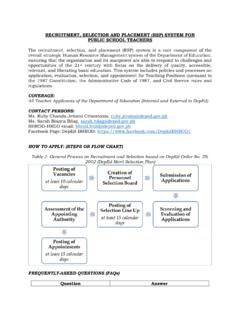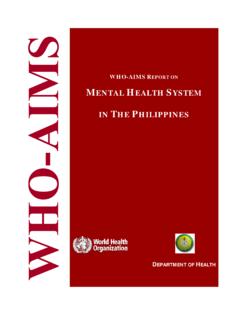Transcription of TABLE OF CONTENTS - Department of Education
1 TABLE OF CONTENTS Enclosure #1 - Guidelines on The Organizational Structures and Staffing Patterns of Stand-Alone and Integrated Public Senior High Schools (SHS) I. Rationale 1 II. Legal Bases 1 III. Scope 1 IV. Definition of Terms 2 V. Policy Statement 3 VI. Guidelines and Procedures 4 A. Classification/Typology of Schools 4 B. Organizational Structures and Staffing Patterns 4 1. Overview of Stand-A lone SHS 5 2. Small Stand-Alone SHS 6 3. Medium Stand-Alone SHS 11 4. Large Stand-Alone SHS 16 5. Very Large Stand-Alone SHS 21 6. Overview of Integrated SHS 26 5. Small Integrated SHS 27 6. Medium Integrated SHS 33 7. Large Integrated SHS 39 8. Very Large Integrated SHS 45 C. General Functions of Teaching and Non-Teaching Staff 51 D. Hiring and Selection of Staff 55 E. Designation of Staff 56 VII. Monitoring and Evaluation 57 A. Senior High Schools 57 B.
2 Schools Division Office 57 C. Regional Office 58 D. Central Office 58 VIII. Repealing Clause 59 IX. Separability Clause 59 X. Transitory Provisions 59 XI. Effectivity 59 Enclosure #2 - Qualification Standards for SHS Non-Teaching Positions (Enclosure to DepEd Order No. 19, s. 2016) Guidelines on the Organizational Structure and Staffing Patterns of Public Stand-Alone and Integrated Senior High Schools (SHS) Page 1 GUIDELINES ON THE ORGANIZATIONAL STRUCTURES AND STAFFING PATTERNS OF STAND-ALONE AND INTEGRATED PUBLIC SENIOR HIGH SCHOOLS (SHS) I. RATIONALE The promulgation of Republic Act No. 9155 (RA 9155), or the Governance of Basic Education Act of 2001, provided the framework for decentralizing the governance of Education to the field. The Department of Education , through its key reform thrust of School-Based Management (SBM), has continuously strived to empower schools and learning centers to effectively address access and quality issues in basic Education .
3 In 2013, Republic Act No. 10533 or the Enhanced Basic Education Act of 2013 provided the Department of Education with the mandate to embark on the landmark K to 12 reform, developing a system of basic Education that would produce learners who are ready for work, entrepreneurship, and higher Education . The introduction and implementation of the additional two (2) years of Senior High School (SHS) completes the Department s shift into the new K to 12 Basic Education Program. To ensure the successful implementation of SHS, the Department has formulated guidelines on the organizational structures and staffing patterns for all public senior high schools. Through this policy, it is envisioned that the principles of shared governance and efficient and effective School-Based Management (SBM) will be applied in all public senior high schools, ensuring the delivery of quality Education that is relevant to the context and needs of every learner.
4 II. LEGAL BASES This policy is guided primarily by the Governance and Basic Education Act of 2001, which mandates the establishment of schools that are empowered to make decisions based on the needs and contexts of the learners they serve. The said act also provides that in addition to the powers of the Secretary of DepEd under existing laws, he/she shall have the authority, accountability, and responsibility to formulate national educational policies and promulgate national educational standards. In order to achieve the vision of well-governed schools, particularly senior high schools, this policy is likewise guided by Section 30 of the Implementing Rules and Regulations (IRR) of the Enhanced Basic Education Act of 2013 which states that DepEd shall formulate the appropriate strategies and mechanisms needed to ensure smooth transition to the K to 12 Basic Education Program.
5 These strategies include, among others, those aimed at improving human resource management and organizational and structural concerns. In this regard, this policy aims to support the implementation of senior high school by providing comprehensive guidelines on its organizational structures and staffing patterns. Guidelines on the Organizational Structure and Staffing Patterns of Public Stand-Alone and Integrated Senior High Schools (SHS) Page 2 III. SCOPE 1. These guidelines shall apply to public senior high schools. It shall cover the organizational structure and staffing patterns of stand-alone and integrated public senior high schools. 2. Hiring and appointment of teaching staff in public senior high schools shall continue to be guided by DepEd Order No. 3, s. 2016 or Hiring Guidelines for Senior High School (SHS) Teaching Positions For School Year (SY) 2016-2017.
6 3. For the hiring, appointment, and promotion of non-teaching positions for SY 2016-2017, including Youth Formation Coordinators, DepEd Order No. 66, s. 2007 or the Revised Guidelines on the Appointment and Promotion of Other Teaching, Related Teaching, and Non-Teaching Positions shall apply. It shall likewise be guided by the guidelines and staffing pattern (Section VI) stipulated in this DepEd Order. 4. Finally, the selection, promotion, and designation of school heads for SY 2016-2017, including Assistant Principals, shall continue to be guided by DepEd Order No. 42, s. 2007 or the Revised Guidelines on the Selection, Promotion, and Designation of School Heads. It shall likewise be guided by the guidelines and staffing pattern (Section VI) stipulated in this DepEd Order. IV. DEFINITION OF TERMS 1. Senior High School (SHS) completes the third stage of compulsory basic Education .
7 It consists of two (2) years (Grades 11 and 12) of high school Education following the completion of four (4) years of Junior High School (JHS). It shall serve as a specialized higher level secondary Education , consisting of different tracks, strands and specializations that learners may choose from depending on their aptitude and interests, and school capacity. 2. Stand-alone SHS is a school situated in a new site separate from a JHS or Integrated School (IS) and has its own School Head. 3. Integrated SHS is a school situated within an existing JHS or IS and shares a School Head with the JHS or IS. 4. Track refers to the specific program in SHS a learner may choose based on his/her interests and aspirations. SHS has four tracks, namely: Academic, Technical-Vocational Livelihood, Arts and Design and Sports.
8 A track is further sub-classified into strands. 5. Strand refers to the specialized curricular offerings under a particular track. 6. SHS Subject Group related SHS subjects grouped according to needed teacher specialization, training, and preparation such that all subjects in any track/strand offered by a school can be taught by qualified teachers. The SHS Subject Groups are as follows: Group I. HUMSS and the following subject groupings: I-A: Oral Communication; Reading and Writing; English for Academic and Professional Purposes; Practical Research Guidelines on the Organizational Structure and Staffing Patterns of Public Stand-Alone and Integrated Senior High Schools (SHS) Page 3 I-B: Komunikasyon at Pananaliksik sa Wika at Kulturang Pilipino; Pagbasa at Pagsusuri ng Iba t I bang Teksto sa Pananaliksik; Pagsulat sa Filipino sa Piling Larangan I-C: 21st Century Literature from the Philippines and the World; Contemporary Philippine Arts from the Region; Understanding Culture, Society and Politics; Introduction to the Philosophy of the Human Person; and related specialized HUMSS subjects I-D: Media and Information Literacy; Empowerment Technologies (for the Strands) Group II.
9 Accountancy, Business and Management (ABM); Entrepreneurship; Research and Work Immersion Group III. Science, Technology, Engineering and Math (STEM) and the following subject groupings: III-A: General Mathematics; Statistics and Probability; and related specialized STEM subjects III-B: Earth Science; Earth and Life Science; Physical Science; and related specialized STEM subjects Group IV. Technical-Vocational Livelihood (TVL) and the following specializations: IV-A: Specialized TVL/Agri-Fisheries IV-B: Specialized TVL/Industrial Arts IV-C: Specialized TVL/ICT IV-D: Specialized TVL/Home Economics Group V. Sports and the following subjects: V-A: Physical Education and Health; Personal Development; and related specialized Sports Subjects Group VI. Arts and Design 7. Learner Support refers to the programs and services of the school that target the holistic development of the learners, and serve as a complement to the curricular offerings of the school.
10 V. POLICY STATEMENT The Department of Education recognizes that schools and learning centers are the heart of the educational system, and are at the core of the delivery of quality basic Education to all Filipino children. Enabling schools to be effective delivery systems of the curriculum entails the alignment of several components, including leadership and management; direction and strategy; pedagogy, technology, systems, and processes; people and people systems; organizational culture; and organizational structure. In implementing the key reforms of the K to 12 basic Education program, it is vital that sufficient support is provided to newly established or expanded senior high schools. This policy aims to ensure that these schools are enabled to produce graduates who are prepared for further Education , employment and Guidelines on the Organizational Structure and Staffing Patterns of Public Stand-Alone and Integrated Senior High Schools (SHS) Page 4 entrepreneurship, through sound organizational structures, efficient and competent staffing, and effective leadership, management, and operations.
